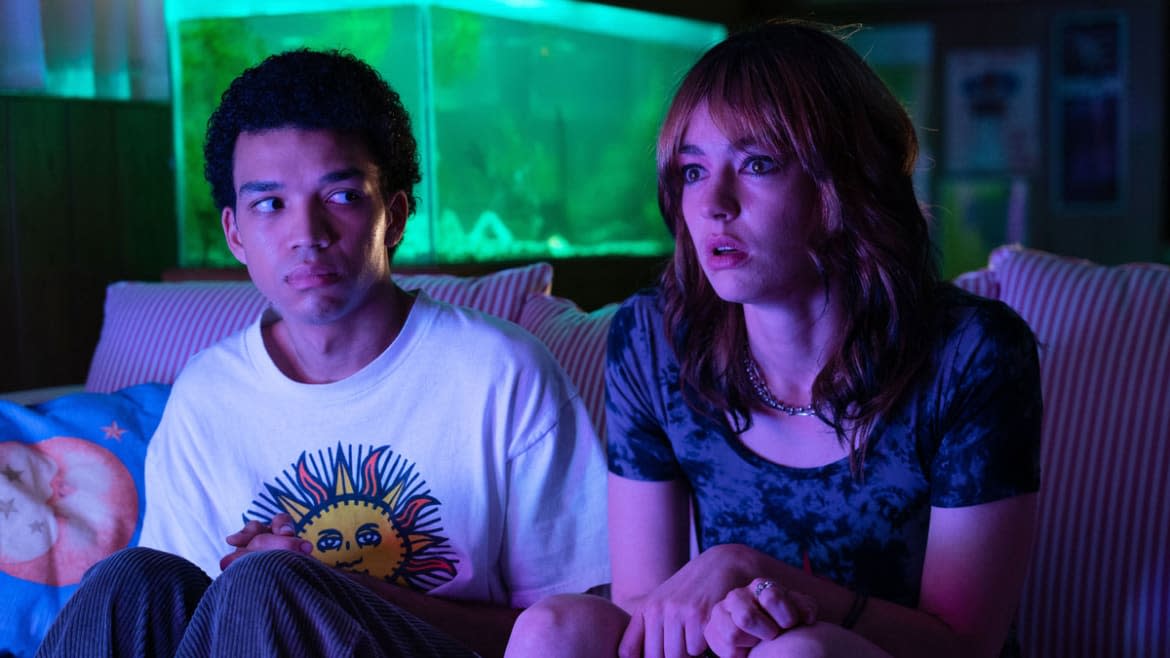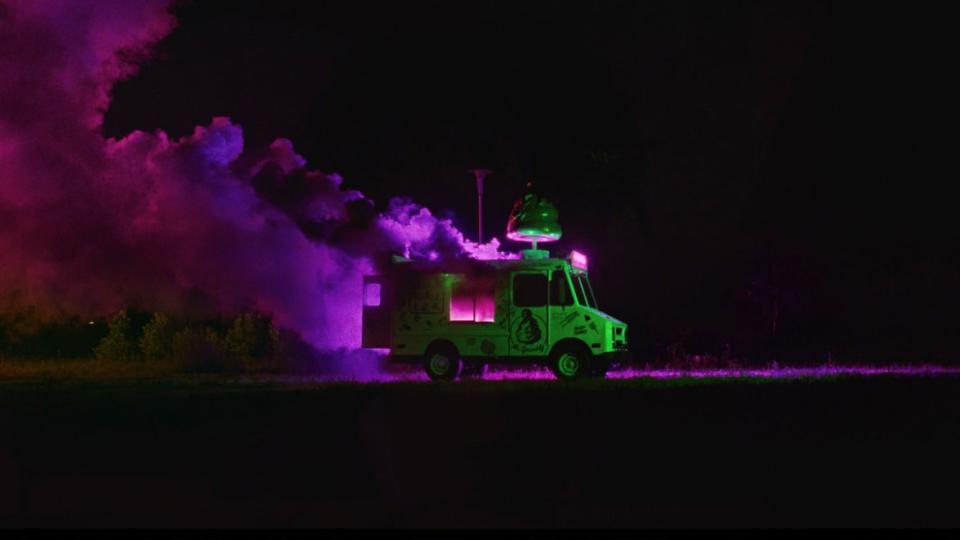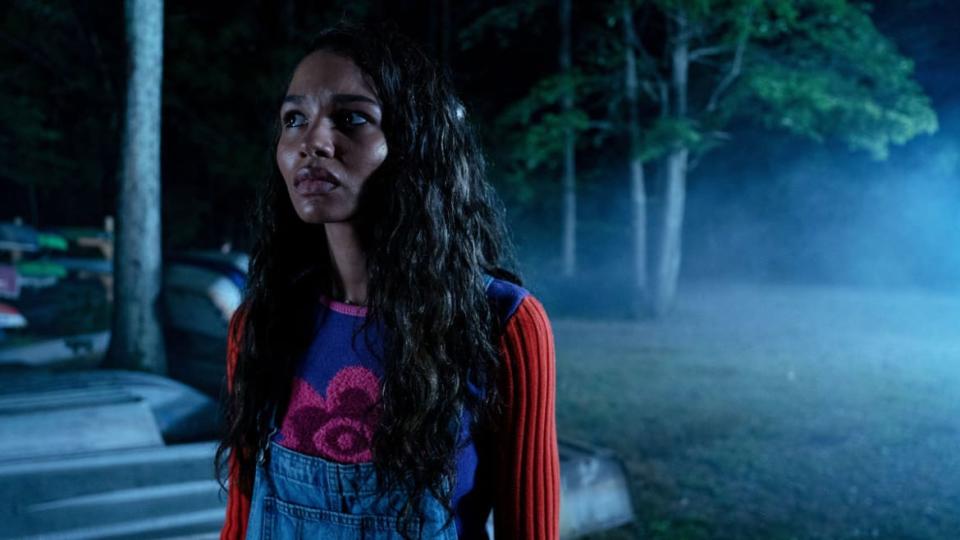How ‘I Saw the TV Glow’ Star Brigette Lundy-Paine Became a ‘Space-Alien Cowboy’

When Brigette Lundy-Paine met director Jane Schoenbrun, they knew they needed to be a part of A24’s emo horror hit, I Saw the TV Glow. It wasn’t that Lundy-Paine (who uses they/them pronouns) shared in Schoenbrun’s specific obsessions; before joining the cast, they had not once watched Buffy the Vampire Slayer, one of the film’s loudest inspirations. Instead, as Lundy-Paine explains it, they have “the same way of delighting in obsession” as Schoenbrun. The two are both into philosophy and theory, and, before long, they were exchanging manifestos about dildos.
I Saw the TV Glow is a story about longing, nostalgia, queerness, and oppression. The film explores, as Lundy-Paine put it at one point during a conversation with The Daily Beast’s Obsessed, what it means to suffer through a social prison—“but also the suffering that is required to break free from it.”
Alongside films like Theda Hammel’s Sundance comedy Stress Positions and Vera Drew’s Warner Bros. parody The People’s Joker, Schoenbrun’s film has helped make 2024 a big year for mainstream films that center trans issues. While Lundy-Paine recognizes the power that trans cinema holds, they also emphasized their belief that it’s not especially healthy to preoccupy oneself with what’s trendy—“especially if it's based around an identity, because in order to exploit an identity, the power must be taken from it.”
As Lundy-Paine put it, “I’m not really interested in sacrificing anything that's uncomfortable or dangerous or about transness. Instead, I'm just going to keep my head to the ground and keep following what I'm interested in.”

A still from I Saw the TV Glow
In this film, Lundy-Paine stars as Maddy—a hard-shelled teen with a monotone voice and an enviable grunge aesthetic. Justice Smith plays Owen, who is a few years younger than Maddy and immediately admires her self assurance. Together, they become consumed by a youth TV series called The Pink Opaque, which follows two powerful girls whose destiny is to save the world from the moon-faced big bad, Mr. Melancholy. Halfway through the film, Maddy disappears only to return a decade later—this time, even more formidable and compelling than before.
“I wanted the adult Maddy to be like a superhero,” Lundy-Paine said. “But, like, creature, dirty superhero.”
The following interview has been lightly edited and condensed for length and clarity.
What attracted you to this project?
I had met Jane through Sam Intili, who’s one of the producers and a longtime friend of mine, and I watched [We’re All Going to the] World's Fair. Then I read the script for TV Glow. It was completely unlike anything that I'd read or seen before. I could feel it was like being at the mouth of a cave—like, I knew that there was this deep, haunting experience that was about to take place.
There was no doubt in my mind that I had to do it, especially after meeting Jane and talking to them, because we got along so well. We had a lot of the same, not really like obsessions with specific things, but the same way of delighting in obsession. I knew that we’d just have so much fun working on this and that we’d both learn so much. And then it was just like a long process of getting A24 to agree to cast me.
‘I Saw the TV Glow’: Meet the Director of the Coolest Movie of the Year
What obsessions did you connect on, and what are your own obsessions that helped inform your character, Maddy?
I am currently kind of obsessed with mythology and the history of religion, and the efforts of the Christian church to convince us of the reality of mythical history. We've had all of these incredibly powerful and spiritual stories reduced to historical events, which actually flattens the consciousness and creates people who are not taught how to be curious.
I think a lot of my obsessions come from that—just reading philosophy and mythology that is disregarding a lot of the Western narrative. Early on, Jane gave me book about—it’s called, oh fuck—it’s a manifesto about everything being a dildo. There’s a contract you have to sign at the beginning that’s about, like, dephallusizing the penis and returning the dildo to its proper place as every tool. We just really got along in that way. The Countersexual Manifesto.
Amazing. And what other research did you do for this role?
I watched Buffy, which was really fun. I’d never seen it, and I need to watch it, like, 50 more times. I'll try to make the space for that in the coming years. But yeah, I think also just listening to a bunch of ’90s music. I got really obsessed with Cat Power and Courtney Love and team Dresch and Elliott Smith. That era of angst really cradled me as I was learning about Maddy. And then also reading about how often live burial is used as a poetic tool.
Also, you know what, it's so funny. I just remembered that I did this and haven't talked about it yet, but I trained with a boxing coach for, like, six months leading up to the movie.
I don't remember there being a big combat scene, right?
You don’t remember the boxing scene?
I’m… trying to remember…
I’m just kidding.
Okay, I’m sitting here like, “You must be messing with me!” So, yeah, what was the boxing training for?
Because I wanted to get strong.
Ah, OK.
I wanted the adult Maddy to be like a superhero. But, like, creature, dirty superhero—which is funny, because I watched the movie, and I'm like, “You still are really skinny and weak.”
Sundance: ‘I Saw the TV Glow’ Is a Haunting Neon Masterpiece
I actually was curious, what do you think about your character’s physical transformation from when Maddy disappears to when she comes back? It’s obviously a completely different look. What emotional resonance did it have to you?
It always buzzes me when Owen says “ma’am” when he sees Maddy in the grocery store, because in my head, I'm like, “Wouldn’t you say ‘sir’?” But that’s part of the experience, I think, that we are with Maddy, almost. It’s almost like Maddy doesn’t even exist when she comes back, but she’s dredged up her midnight realm human form from where she safely was in the Pink Opaque.
The form of Return Maddy, I think, is ripped through the static. Because, you know, we have the Pink Opaque that Maddy and Owen see, and then we have the Pink Opaque that Owen sees at the end—the kind of cheesy TV show, soundstage version. And so, the real Pink Opaque is this Maddy that we see. And to me, she’s like, space alien, creature—totally unconcerned with normal human behavior.
Since I saw this movie at Sundance, I feel like there’s been a growing conversation about what a big year this is for trans cinema. I wonder what your relationship is to that conversation.
First of all, there’s always been a trans cinema movement. And second of all, there really are, like, three films right now. There’s Jane’s movie, Theda [Hammel]’s movie [Stress Positions], and then The People’s Joker. And so I think it's funny that the intensity of these films is powerful enough for people to think that there’s like a trans movement in cinema, because there is, but this is only the very beginning of it.
I think trans cinema is deeply threatening to everything that upholds this white supremacist, capitalist civilization that we’re all sort of suffering through, and that’s what the movie is about, is what it means to suffer through the social prison, but also the suffering that is required to break free from it.
Personally, I’m only focused on what myself and my community are working on. I don’t think it’s healthy to pay too much attention to what’s trendy, especially if it’s based around an identity, because in order to exploit an identity, the power must be taken from it. I’m not really interested in sacrificing anything that’s uncomfortable or dangerous or about transness. Instead, I’m just going to keep my head to the ground and keep following what I'm interested in.
But I feel so excited about all three of these movies. I haven’t seen The People’s Joker. I saw Stress Positions; it’s excellent. And yeah, trans people are not going anywhere, and we’ve been here for a long time, and it’s always a great idea to go back to the history of trans cinema and check some some old shit out, because it’s good, and it’s unhinged, and and it’s gonna feed your soul.

Helena Howard
I’d be curious what you think of The People’s Joker, because I think it hits on a lot of the same themes in terms of examining our relationships with media as both a source of comfort and a tool of repressive capitalism. Another thing that I wondered was how you feel music shapes this film’s emotional story.
I think music is a huge part of the experience of watching this film. The moment that I always lock into the depth of its power is King Woman’s performance of “Psychic Wound” at The Double Lunch.
It’s perspective—music in this movie is used as a nostalgic comfort, but it’s also Narrator Owen looking back on his life, the way that we listen to the music of our youth. Even through the pain and the missed opportunity, it still brings us comfort.
The soundtrack is just gonna slap. I can't wait to listen to it.
If you were to think of your nostalgic comforts, be they music or TV shows, what would they be for you?
I really am such a corny musichead. Like, when I want to feel really comfy, I’ll listen to Usher and Ne-Yo. I got so into Muni Long recently, which is not nostalgic, but she’s just my comfort of late. Muni Long, Summer Walker, and Jazmine Sullivan. I love them all so much. But also, Leonhard Cohen and The Velvet Underground are my comfort ’70s boy music.
Get the Daily Beast's biggest scoops and scandals delivered right to your inbox. Sign up now.
Stay informed and gain unlimited access to the Daily Beast's unmatched reporting. Subscribe now.

 Yahoo News
Yahoo News 
